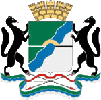 |

Siberia in Brief
- Industrial Region
Industry is a leading branch of economy in Siberian Federal District (SFD). Siberian gross regional product volume is 11.4% of Russian gross national product. Region's share in Russia's industrial production is 12.4%. Key Siberian industries are: non-ferrous metallurgy, electric power industry, woodwork and timber industry, iron and steel industry, chemical and petrochemical industries, food and flour-milling industry, fuel industry, industry of construction materials, machine-building and metal-working, consumer goods industry.
- Main Russia's Source of Energy and Raw Materials
SFD has a great percentage of Russian energy and mineral resources at its territory: 77% of oil, 85% of gas, 80% of coal, 70% of copper, 68% of nickel, 85% of lead, 41% of gold, and 99% of platinum group metals. Total area of forest resource is 346321.7 thousand hectares.
- Main Russia's Transportation Node
Siberia is crossed by main cargo and passenger transit routes connecting European and Asian parts of Russia. SFD's share of Russia's total railway length is 17.5%, 16.8% of motor roads and 29.7% of internal navigable waterways lie on its territory.
- Attractiveness for International Cooperation
Many countries have opened their representation offices in SFD, such as Germany, Mongolia, Poland, Israel, Italy, Republic of Belarus, Bulgaria and many others.
Altai Republic
Largest city: Gorno-Altaysk (administrative center)
Area – 92.6 thousand sq km
Population – 202.9 thousand people
Largest gold, silver, and copper processing factories are located in the region.
Buryat Republic
Largest city: Ulan-Ude (administrative center)
Area – 351.3 thousand sq km
Population – 981.2 thousand people
There are large-scale deposits of metal ores, gold, asbestos, coal, uranium and many other minerals in the region.
Tuva Republic
Largest city: Kyzyl (administrative center)
Area – 170.5 thousand sq km
Population – 305.5 thousand people
Main areas of activity: non-ferrous metallurgy, electric power industry, and food industry.
Republic of Khakassia
Largest cities: Abakan (administrative center), Sayanogorsk, Chernogorsk
Area – 61.9 thousand sq km
Population – 546 thousand people
Main industry branches: non-ferrous metallurgy and fuel industry. Power supply system includes Sayano-Shushenskaya and Mainskaya
hydroelectric power stations.
Altai Krai
Largest cities: Barnaul (administrative center), Biysk, Zarinsk, Novoaltaysk, Rubtsovsk
Area – 169.1 thousand sq km
Population – 2607.4 thousand people
Main activities: machine building, food industry, and defense enterprises.
Zabaykalskiy Krai
Largest cities: Chita (administrative center), Krasnokamensk, Aginskoye urban-type settlement
Area – 431.5 thousand sq km
Population – 1227.5 thousand people
It is one of the oldest ore mining regions of Russia. Largest coal-mining enterprises are Chitaugol LLC, Kvarts LLC, Zabaykalskiy GOK (mining and concentration complex) JSC.
Krasnoyarsk Krai
Largest cities: Krasnoyarsk (administrative center), Achinsk, Zheleznogorsk, Zelenogorsk, Kansk, Lesosibirsk, Minusinsk, Nazarovo, Norilsk, Talnakh
Area – 2339.7 thousand sq km
Population – 2966 thousand people
This region is one of the richest in minerals and natural resources in Russia. More than 95% of Russian nickel resources and 20% of gold resources are located in this region. Major financial industrial groups reside or carry out operations in Krasnoyarsk Krai: Norilskiy Nickel, MDM Group – SUEK (Siberian Coal Energy Company), RAO Unified Energy System of Russia, and Russian Railways.
Irkutsk Oblast
Largest cities: Irkutsk (administrative center), Angarsk, Bratsk, Tulun, Usolye-Sibirskoye, Ust-Ilimsk, Cheremkhovo, Ust-Odynskiy settlement
Area – 790.3 thousand sq km
Population – 2654 thousand people
Four largest in Siberia hydroelectric power stations (HPS) operate at the territory of this oblast: Irkutsk HPS, Bratsk HPS, Ust-Ilim HPS, and Mamakan HPS.
Kemerovo Oblast
Largest cities: Kemerovo (administrative center), Anzhero-Sudzhensk, Belovo, Kisilevsk, Leninsk-Kuznetskiy, Mezhdurechensk, Novokuznetsk, Osinniki, Prokopyevsk, Yurga
Area – 95.5 thousand sq km
Population – 2899.1 thousand people
Located at the territory of this oblast, Kuzbas is one of the largest coal basins by resources and production volume.
Novosibirsk Oblast
Largest cities: Novosibirsk (administrative center), Berdsk, Iskitim
Area – 178.2 thousand sq km
Population – 2692.2 thousand people
Novosibirsk is Russia's third largest city and the largest city in Siberia. It is also the administrative center of Siberian Federal District. Russian Federation President representation office is located here.
Omsk Oblast
Largest city: Omsk (administrative center)
Area – 141.1 thousand sq km
Population – 2079.2 thousand people
Oblast's industry structure: fuel and energy branches – 33.4%, food – 26.7%, machine-building and metal-working – 15.3%, chemical and petrochemical – 14.9%, consumer goods industry – 0.6%, others – 9.2%.
Tomsk Oblast
Largest cities: Tomsk (administrative center), Seversk
Area – 316.9 thousand sq km
Population – 1046.0 thousand people
Main economic development priorities in this oblast include fuel and energy complex, scientific and educational sector, as well as small businesses.
|
 |






